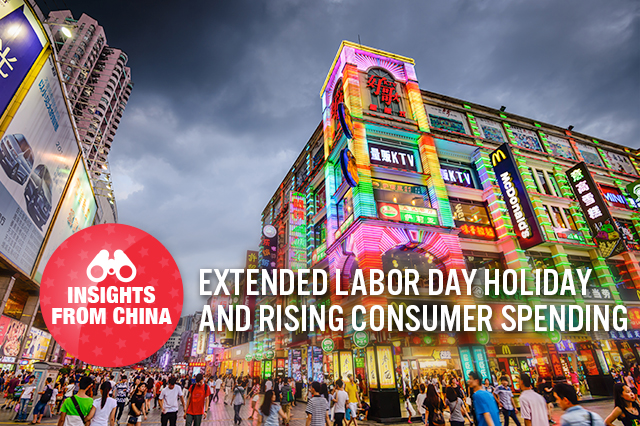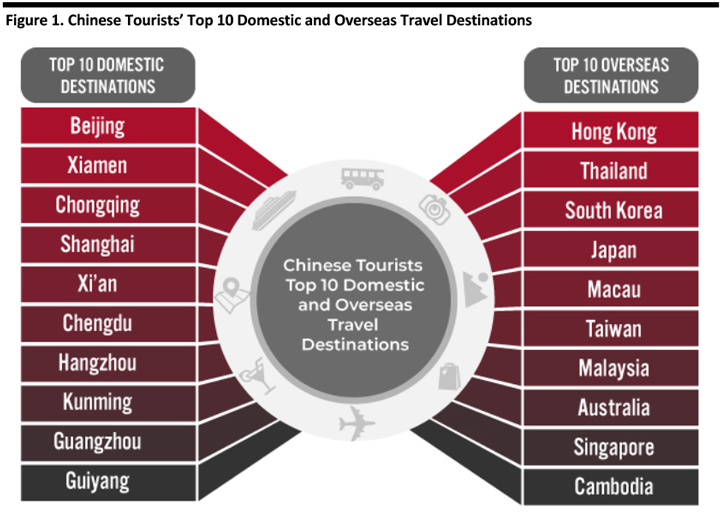
DIpil Das
In 2019, China extended the Labor Day holiday to get people to travel and spend more. Usually, the Labor Day holiday is a three-day break: Labor Day plus the closest weekend. In 2018, the holiday ran from Sunday April 29 to Tuesday May 1 – but people had to work on April 28 (Saturday) to compensate for the extra day off on Monday (April 30).
This year, people had a four-day break starting from the Labor Day holiday on May 1 (which fell on a Wednesday this year) to Saturday May 4, to encourage more travel and spending, according to the State Council. However, to make up for two weekdays off on May 2-3, people had to work on two Sundays: April 28 and May 5.
Rising Tourism Revenue Over the Labor Day Holiday
During the holiday in 2019, tourism revenue grew 16.1% year over year to ¥117.7 billion ($17.5 billion), with the number of tourists taking domestic trips increasing 13.7% year over year to 195 million, according to the Ministry of Culture and Tourism. On May 1, 17.24 million railway trips were made, a 44.3% increase year over year, according to the China Railway Corporation.
Beijing ranked the most popular domestic travel destination during this year’s Labor Day holiday, according to online travel agency Ctrip. Alibaba’s payment platform Alipay reported Hong Kong as the most popular “overseas” travel destination for Chinese tourists during the break. (Although part of China, Hong Kong maintains its own customs and immigration regime, so visitors from China need to pass through immigration to enter the city.) Ctrip reported 30% of its bookings during the holiday period were made by people who were born in the 1990s, followed by 27% from those born in the 1980s.
[caption id="attachment_89432" align="aligncenter" width="720"] Source: Ctrip/Alipay/Coresight Research[/caption]
Alipay said the four overseas destinations in which Chinese tourists spent the most were: the United Arab Emirates (with an average per tourist spend of ¥3,275, or $477), Korea (¥2,770, or $403), Japan (¥2,485, or $362) and Hong Kong (¥1,868, or $272).
Growing Retail Sales During the Labor Day Holiday
Holiday tourism also boosted travel-related retail markets. Sales of travel insurance rose 14.4% year over year, according to leading Chinese retailer Suning.com. Sales of travel products such as children’s car seats on Suning.com surged 87% while pet bags jumped 200% year over year.
Food and beverage sales soared during the holiday. Suning.com reported beer consumption climbed 716% year over year, followed by snacks (433%) and crawfish (246%). Alibaba’s domestic e-commerce platform Taobao said it sold more than 360,000 kilograms (over 790,000 pounds) of cherries, around 400,000 kilograms of durians, and over 430,000 kilograms of bananas. Alibaba’s cross-border e-commerce platform Tmall Global reported the top three categories over the holiday were beauty products, health care products, and mom and baby products.
Box office revenue over the holiday period also climbed to more than ¥1.5 billion (around $222 million) from around ¥999 million (around $147 million) in 2018, up 50% year over year, according to Chinese media company Xinhuanet. More than 35 million people went to the cinema during this year’s Labor Day holiday.
Key Insights
China leveraged the extended Labor Day holiday to encourage citizens to spend more. The government’s decision to extend the holiday was partly a response to downward economic pressure, as the impact of infrastructure investment stimulus is weakening, but is also in line with the government’s long-term policy of developing a stronger domestic market to reduce dependence on exports. Domestic tourists, retail sales of certain categories and cinema box office revenue increased during the holiday. These show that the extended holiday did have the desired effect of boosting consumption over the holiday.
Source: Ctrip/Alipay/Coresight Research[/caption]
Alipay said the four overseas destinations in which Chinese tourists spent the most were: the United Arab Emirates (with an average per tourist spend of ¥3,275, or $477), Korea (¥2,770, or $403), Japan (¥2,485, or $362) and Hong Kong (¥1,868, or $272).
Growing Retail Sales During the Labor Day Holiday
Holiday tourism also boosted travel-related retail markets. Sales of travel insurance rose 14.4% year over year, according to leading Chinese retailer Suning.com. Sales of travel products such as children’s car seats on Suning.com surged 87% while pet bags jumped 200% year over year.
Food and beverage sales soared during the holiday. Suning.com reported beer consumption climbed 716% year over year, followed by snacks (433%) and crawfish (246%). Alibaba’s domestic e-commerce platform Taobao said it sold more than 360,000 kilograms (over 790,000 pounds) of cherries, around 400,000 kilograms of durians, and over 430,000 kilograms of bananas. Alibaba’s cross-border e-commerce platform Tmall Global reported the top three categories over the holiday were beauty products, health care products, and mom and baby products.
Box office revenue over the holiday period also climbed to more than ¥1.5 billion (around $222 million) from around ¥999 million (around $147 million) in 2018, up 50% year over year, according to Chinese media company Xinhuanet. More than 35 million people went to the cinema during this year’s Labor Day holiday.
Key Insights
China leveraged the extended Labor Day holiday to encourage citizens to spend more. The government’s decision to extend the holiday was partly a response to downward economic pressure, as the impact of infrastructure investment stimulus is weakening, but is also in line with the government’s long-term policy of developing a stronger domestic market to reduce dependence on exports. Domestic tourists, retail sales of certain categories and cinema box office revenue increased during the holiday. These show that the extended holiday did have the desired effect of boosting consumption over the holiday.
 Source: Ctrip/Alipay/Coresight Research[/caption]
Alipay said the four overseas destinations in which Chinese tourists spent the most were: the United Arab Emirates (with an average per tourist spend of ¥3,275, or $477), Korea (¥2,770, or $403), Japan (¥2,485, or $362) and Hong Kong (¥1,868, or $272).
Growing Retail Sales During the Labor Day Holiday
Holiday tourism also boosted travel-related retail markets. Sales of travel insurance rose 14.4% year over year, according to leading Chinese retailer Suning.com. Sales of travel products such as children’s car seats on Suning.com surged 87% while pet bags jumped 200% year over year.
Food and beverage sales soared during the holiday. Suning.com reported beer consumption climbed 716% year over year, followed by snacks (433%) and crawfish (246%). Alibaba’s domestic e-commerce platform Taobao said it sold more than 360,000 kilograms (over 790,000 pounds) of cherries, around 400,000 kilograms of durians, and over 430,000 kilograms of bananas. Alibaba’s cross-border e-commerce platform Tmall Global reported the top three categories over the holiday were beauty products, health care products, and mom and baby products.
Box office revenue over the holiday period also climbed to more than ¥1.5 billion (around $222 million) from around ¥999 million (around $147 million) in 2018, up 50% year over year, according to Chinese media company Xinhuanet. More than 35 million people went to the cinema during this year’s Labor Day holiday.
Key Insights
China leveraged the extended Labor Day holiday to encourage citizens to spend more. The government’s decision to extend the holiday was partly a response to downward economic pressure, as the impact of infrastructure investment stimulus is weakening, but is also in line with the government’s long-term policy of developing a stronger domestic market to reduce dependence on exports. Domestic tourists, retail sales of certain categories and cinema box office revenue increased during the holiday. These show that the extended holiday did have the desired effect of boosting consumption over the holiday.
Source: Ctrip/Alipay/Coresight Research[/caption]
Alipay said the four overseas destinations in which Chinese tourists spent the most were: the United Arab Emirates (with an average per tourist spend of ¥3,275, or $477), Korea (¥2,770, or $403), Japan (¥2,485, or $362) and Hong Kong (¥1,868, or $272).
Growing Retail Sales During the Labor Day Holiday
Holiday tourism also boosted travel-related retail markets. Sales of travel insurance rose 14.4% year over year, according to leading Chinese retailer Suning.com. Sales of travel products such as children’s car seats on Suning.com surged 87% while pet bags jumped 200% year over year.
Food and beverage sales soared during the holiday. Suning.com reported beer consumption climbed 716% year over year, followed by snacks (433%) and crawfish (246%). Alibaba’s domestic e-commerce platform Taobao said it sold more than 360,000 kilograms (over 790,000 pounds) of cherries, around 400,000 kilograms of durians, and over 430,000 kilograms of bananas. Alibaba’s cross-border e-commerce platform Tmall Global reported the top three categories over the holiday were beauty products, health care products, and mom and baby products.
Box office revenue over the holiday period also climbed to more than ¥1.5 billion (around $222 million) from around ¥999 million (around $147 million) in 2018, up 50% year over year, according to Chinese media company Xinhuanet. More than 35 million people went to the cinema during this year’s Labor Day holiday.
Key Insights
China leveraged the extended Labor Day holiday to encourage citizens to spend more. The government’s decision to extend the holiday was partly a response to downward economic pressure, as the impact of infrastructure investment stimulus is weakening, but is also in line with the government’s long-term policy of developing a stronger domestic market to reduce dependence on exports. Domestic tourists, retail sales of certain categories and cinema box office revenue increased during the holiday. These show that the extended holiday did have the desired effect of boosting consumption over the holiday.